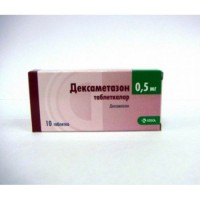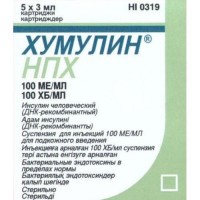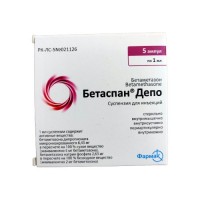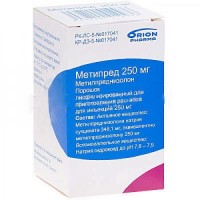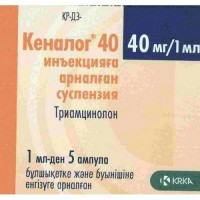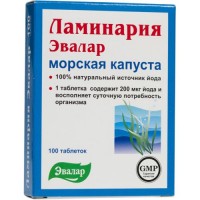TRADJENTA® (Linagliptin) 5 mg (30 film-coated tablets)
- $104.70
Structure
One tablet contains the active substance - linagliptin 5 mg,
excipients: mannitol, pregelatinized starch, corn starch, copovidone, magnesium stearate
What is TRADJENTA?
- TRADJENTA is a medicine used along with diet and exercise to lower blood sugar in adults with type 2 diabetes.
- TRADJENTA is not for people with type 1 diabetes.
- TRADJENTA is not for people with diabetic ketoacidosis (increased ketones in the blood or urine).
- If you have had pancreatitis in the past, it is not known if you have a higher chance of getting pancreatitis while you take TRADJENTA.
- It is not known if TRADJENTA is safe and effective in children under 18 years of age.
Indications for use
Tradjenta is indicated for adult patients with type 2 diabetes mellitus as an adjunct to diet and exercise to improve glycemic control:
Monotherapy
- with intolerance to metformin or in the presence of contraindications to its use due to renal failure.
Combination therapy
- in combination with other antidiabetic drugs, including insulin, in patients with insufficient glycemic control
Method of administration and dosage
Dosage
The recommended dose is 5 mg of linagliptin (1 tablet) once a day. When linagliptin is given in combination with metformin, the metformin dose must be maintained and linagliptin taken as a concomitant drug.
When linagliptin is used in combination with sulfonylurea derivatives or insulin, it may be necessary to reduce the dose of sulfonylureas or insulin derivatives to reduce the risk of hypoglycemia.
Special patient groups
Renal failure
No dose adjustment is required in patients with renal insufficiency.
Liver failure
Pharmacokinetic studies show that dose adjustment is not required in patients with hepatic impairment, but there is no sufficient clinical experience in these patients.
Elderly patients
No dose adjustment is necessary based on age. Clinical data in patients over 80 years of age are insufficient, therefore, caution must be exercised when prescribing in this group of patients.
Children
The efficacy and safety of linagliptin use in children and adolescents under 18 years of age has not been established. No data available.
Mode of application
Tradjenta is taken orally, regardless of the time and meal. If missed, the drug should be taken as soon as possible. Do not take a double dose on the same day.
Who should not take TRADJENTA?
Do not take TRADJENTA if you:
- are allergic to linagliptin or any of the ingredients in TRADJENTA.
Symptoms of a serious allergic reaction to TRADJENTA may include:
- skin rash, itching, flaking or peeling
- raised red patches on your skin (hives)
- swelling of your face, lips, tongue and throat that may cause difficulty in breathing or swallowing
- difficulty with swallowing or breathing
If you have any of these symptoms, stop taking TRADJENTA and call your doctor right away or go to the nearest hospital emergency room.
How should I take TRADJENTA?
- Take TRADJENTA exactly as your doctor tells you to take it.
- Take 1 tablet 1 time each day with or without food.
- If you miss a dose, take it as soon as you remember. If you do not remember until it is time for your next dose, skip the missed dose and go back to your regular schedule. Do not take two doses of TRADJENTA at the same time.
- Your doctor may tell you to take TRADJENTA along with other diabetes medicines. Low blood sugar can happen more often when TRADJENTA is taken with certain other diabetes medicines. See “What are the possible side effects of TRADJENTA?”
- If you take too much TRADJENTA, call your doctor or local poison control center or go to the nearest hospital
emergency room right away.
- Check your blood sugar as your doctor tells you to.
Side effects requiring immediate medical attention
Along with its needed effects, linagliptin (the active ingredient contained in Tradjenta) may cause some unwanted effects. Although not all of these side effects may occur, if they do occur they may need medical attention.
Check with your doctor immediately if any of the following side effects occur while taking linagliptin:
More common
- Anxiety
- blurred vision
- chills
- cold sweats
- confusion
- cool, pale skin
- depression
- dizziness
- fast heartbeat
- headache
- increased hunger
- loss of consciousness
- nausea
- nightmares
- seizures
- shakiness
- slurred speech
- unusual tiredness or weakness
Incidence not known
- Bloating
- constipation
- cough
- fever
- hives, welts, itching, or skin rash
- large, hard skin blisters
- large, hive-like swelling on the face, eyelids, lips, tongue, throat, hands, legs, feet, or sex organs
- loss of appetite
- pains in the stomach, side, or abdomen, possibly radiating to the back
- puffiness or swelling of the eyelids or around the eyes, face, lips, or tongue
- redness of the skin
- severe joint pain
Side effects not requiring immediate medical attention
Some side effects of linagliptin may occur that usually do not need medical attention. These side effects may go away during treatment as your body adjusts to the medicine. Also, your health care professional may be able to tell you about ways to prevent or reduce some of these side effects.
Check with your health care professional if any of the following side effects continue or are bothersome or if you have any questions about them:
More common
- Muscle aches
- sore throat
- stuffy or runny nose
Less common
- Diarrhea

